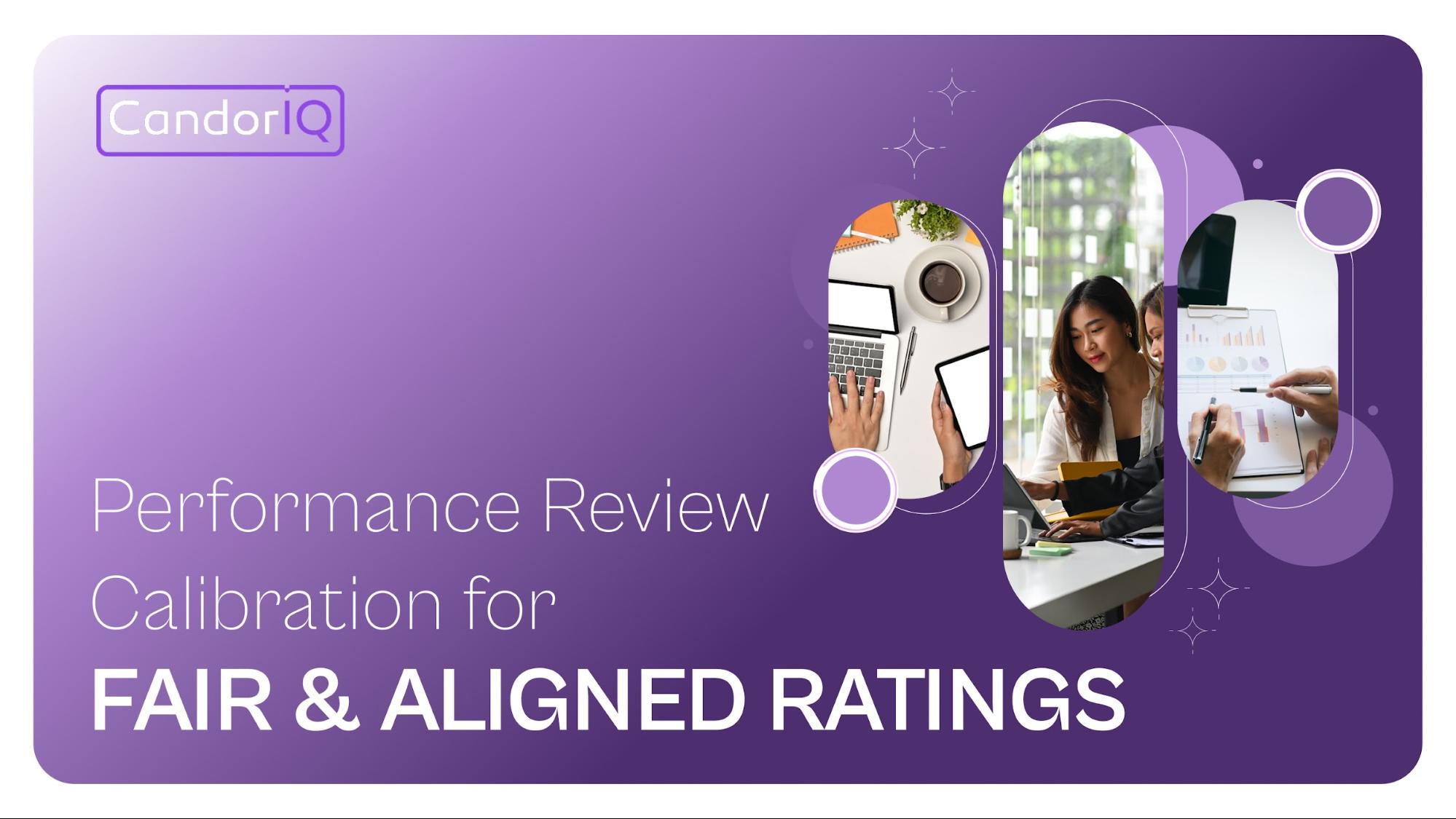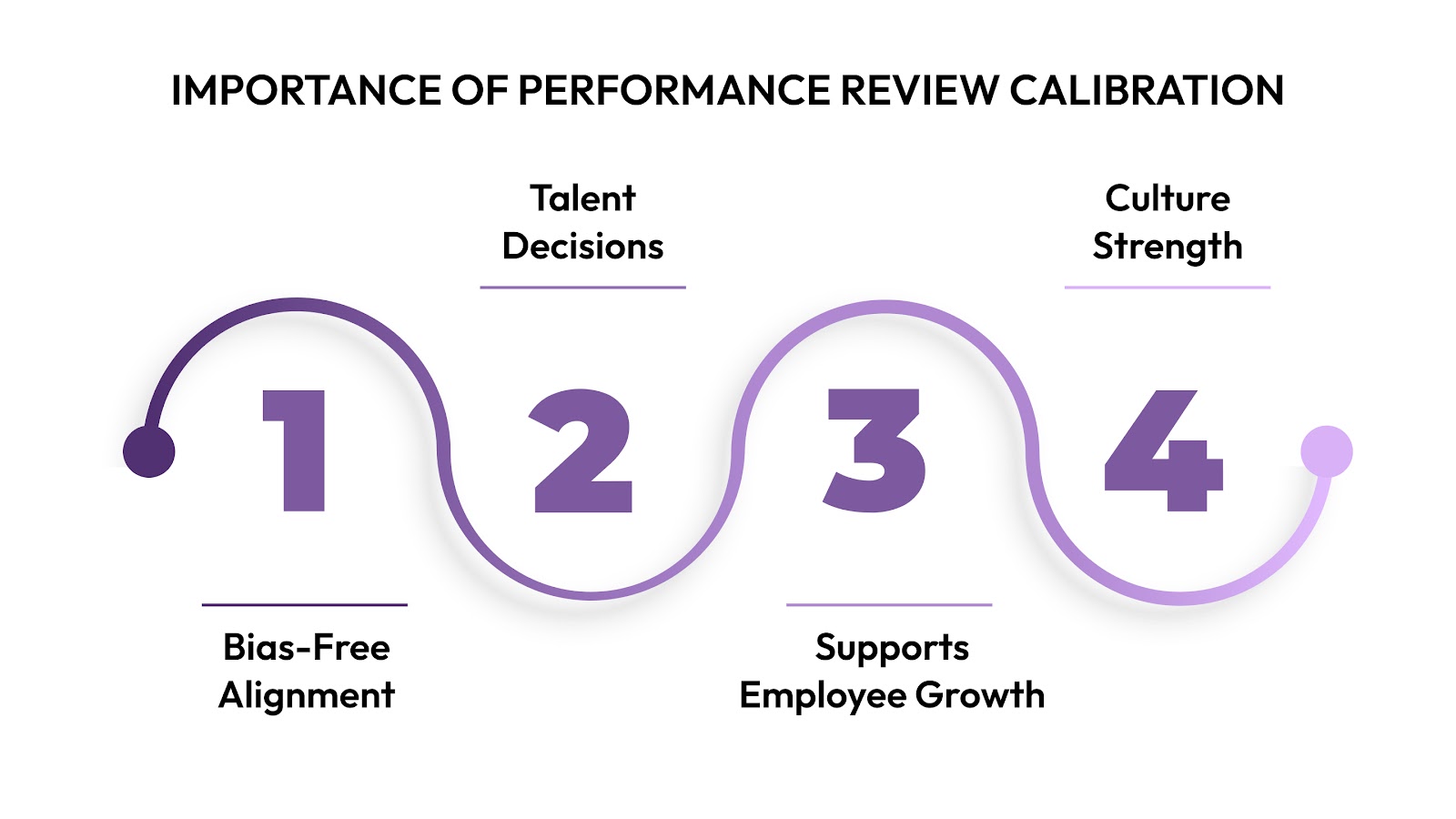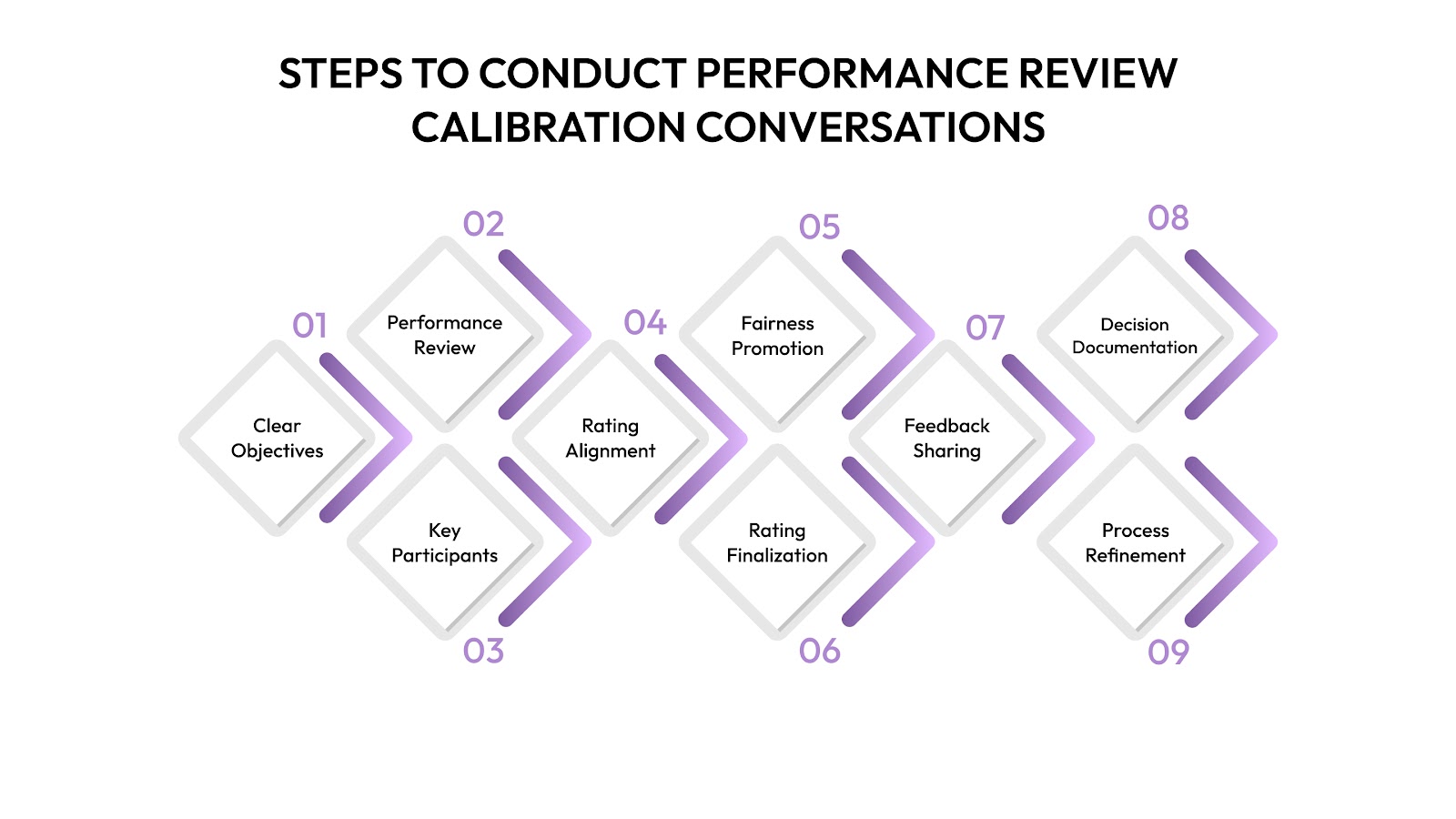Understanding Performance Review Calibration for Fair & Aligned Ratings
Explore how performance review calibration ensures fairness, reduces bias, aligns ratings, and supports consistent feedback across teams and departments.

Getting compensation right isn’t just about numbers; it’s about valuing your people. When employees feel recognized, respected, and fairly rewarded, they’re more likely to stay, grow, and give their best.
We know how tough it can be when performance reviews feel inconsistent or subjective, especially when people’s careers, morale, and pay decisions are on the line. That’s why a consistent, data-backed approach helps you avoid short-term fixes and build lasting trust. And as your teams evolve, it helps you make fair and consistent pay decisions that scale with your company.
This guide walks you through what performance review calibration is, why it matters, and how to lead effective calibration conversations. It also covers common challenges, best practices, and the key role HR plays in the process.
TL;DR
- Use consistent performance standards to reduce favoritism and rating gaps.
- Collaborative reviews help catch and fix bias for fairer outcomes.
- Keep evaluations focused on business drivers like innovation and accountability.
- Calibrated reviews guide better decisions on promotions, raises, and growth.
What is Performance Review Calibration?
Performance review calibration is a structured process where HR and managers come together to align employee ratings. The goal is to ensure evaluations are fair, bias-free, and consistent, no matter the team or reviewer. Using shared criteria makes reviews more objective, regardless of team or reviewer.
This is especially important in companies with diverse teams or multiple departments, where consistency can easily slip. When done right, calibration supports equity and transparency; it also helps employees feel confident that their work is being recognized and evaluated fairly.
This sense of fairness and consistency is exactly why performance review calibration has become such a critical part of modern performance management.
Importance of Performance Review Calibration

Calibration ensures everyone is evaluated the same way. However, its impact extends beyond simply ensuring equity. When done well, calibration builds trust in the review process, boosts employee satisfaction, and supports long-term engagement and retention.
Here’s why it matters so much:
- Reduces Bias and Aligns with Company Goals: Calibration ensures ratings reflect real performance, not personal bias, and stay aligned with strategic outcomes like innovation, efficiency, or collaboration.
- Leads to Better Talent Decisions: More accurate ratings help leadership make informed decisions about promotions, compensation, and development, ensuring top talent is rewarded and supported.
- Supports Employee Growth: By revealing performance trends and skill gaps, calibration enables managers to offer more targeted feedback and growth opportunities.
- Strengthens Company Culture: Fair, consistent reviews encourage a culture of accountability and recognition where employees feel motivated, valued, and engaged.
Understanding the value of calibration is only the beginning. To put it into action, companies need a clear and collaborative process.
Also Read: Understanding Performance-Based Compensation: Pros and Cons
Steps to Conduct Performance Review Calibration Conversations

Performance review calibration conversations play a crucial role in making sure performance evaluations are fair, consistent, and transparent. These sessions bring together managers, HR, and leadership to align the rating of employees across teams and departments.
Here are the key steps to lead effective performance calibration conversations:
1. Set Clear Objectives Before the Meeting
Begin by defining what the calibration session aims to achieve, such as aligning ratings, resolving discrepancies, or reinforcing fairness. Share performance criteria and relevant data in advance so all participants come prepared and know what standards to follow.
For instance, if your company rates employees on a 5-point scale, clarify what a “3” or “4” truly means in terms of behaviors and results.
2. Gather and Review Performance Data
Ensure that all performance reviews, feedback, and self-assessments are complete and accurate before the meeting. Identify outliers and flag any ratings that seem inconsistent or require deeper discussion so the focus stays on areas that need attention.
For instance, if two sales managers rate their top performers very differently, like one gives mostly 4s and 5s while the other sticks to 3s, it’s worth digging into what each considers “exceeds expectations."
3. Include the Right People
Invite department heads, HR partners, and leaders who are closely involved in performance management. Make sure they’re familiar with the process, company goals, and evaluation criteria to ensure informed and consistent input. Avoid letting one strong personality dominate the conversation. Everyone should have a voice.
4. Discuss and Align Ratings
During the meeting, compare ratings, spot inconsistencies, and make necessary adjustments. Start with top performers to confirm recognition, then address underperformers. Encourage open discussion, ask for supporting examples, and make changes based on agreed-upon standards.
If two employees in similar roles show the same results, they should have similar ratings, unless there’s clear context explaining the difference.
5. Watch for Bias and Promote Fairness
Use the session to surface and address any unconscious bias. Ask managers to justify their ratings using data rather than assumptions and consider carefully the implications for fairness and inclusion. Use data and behavior-based evidence to steer the conversation.
6. Finalize Ratings and Confirm Alignment
Once discussions are complete, finalize performance ratings based on group consensus. Ensure that everyone agrees on the outcomes and that the results align with company goals and performance standards.
7. Share Feedback with Employees
After calibration, managers should meet with their team members to share final ratings. Provide clear feedback with specific examples, and for those who need improvement, outline the next steps and development plans.
8. Document Outcomes and Decisions
Record all final ratings in your system and note reasons for any major changes. Summarize key outcomes to support transparency and show how the process aligns with business priorities.
9. Review and Refine the Process
Wrap up with a debrief involving HR and managers to gather feedback. Identify patterns or misalignments that may need attention, and use those insights to improve your calibration process before the next review cycle.
Even with a solid process in place, calibration conversations can come with hurdles, ranging from time constraints to inconsistent rating standards.
Challenges & Solutions in Performance Review Calibration
Performance review calibration is crucial to ensuring evaluations are fair, consistent, and aligned across the organization. But like any critical process, it comes with its own set of challenges.
To make it truly effective, companies need to understand what can go wrong and how to fix it. Let’s look at some common challenges in performance review calibration and practical ways to overcome them.
Solving common challenges is important, but sustaining fairness takes consistent effort. To make calibration truly impactful, companies must adopt practices that consistently promote fairness, objectivity, and alignment across their teams.
Best Practices for Effective Performance Review Calibration

Effective calibration aligns reviews with company goals, supports fair promotions and pay decisions, and strengthens trust by reducing bias. To optimize calibration, it’s essential to follow a few key best practices. Here’s what works:
- Standardize Performance Criteria: Ensure that all managers use the same set of performance standards, which reflect your company’s goals and values. Set clear criteria, like productivity or teamwork, that everyone understands and uses consistently across every team.
- Train Managers to Recognize Bias: Help managers identify and reduce unconscious bias by offering training and practical tools. When managers understand how bias can show up and how to avoid it, they’re more likely to focus on objective performance factors, leading to fairer evaluations.
- Schedule Regular Calibration Meetings: Instead of waiting until the end of the review cycle, hold calibration meetings more frequently. These regular check-ins allow teams to catch and correct discrepancies early, making the final review process smoother and more accurate.
- Involve Cross-Functional Leaders: Invite senior leaders or department heads from various areas to participate in calibration discussions. Their broader perspective can help ensure ratings are consistent across departments and aligned with company-wide standards.
- Use Performance Data for Ratings: Start with clear metrics like KPIs (Key Performance Indicators) and quantifiable data such as sales numbers or project timelines that reflect job performance. CandorIQ supports this approach across teams.
- Encourage Open Communication: Create space for honest conversations during calibration sessions. When managers openly discuss their reasoning, share feedback, and offer suggestions for growth, it leads to better alignment and helps employees get the support they need.
- Maintain Detailed Documentation: Ensure that each performance rating is supported by clear, documented evidence. Note specific achievements, behaviors, or outcomes that justify the rating. This adds transparency and makes it easier to explain decisions if questions come up later.
- Use Performance Reviews to Guide Growth and Career Planning: Don’t treat performance reviews as standalone events. Use them to guide career development by discussing training opportunities, mentorship, or new responsibilities. This shows employees that their growth is a priority and keeps them engaged.
- Be Transparent About the Process: Clearly communicate to employees how calibration works. Share what’s being evaluated, how inconsistencies are addressed, and what factors influence final ratings. Transparency promotes trust and helps employees understand how to grow and succeed.
- Continuously Improve the Process: After each review cycle, gather feedback from managers on what worked and what didn’t. Look for patterns, challenges, or areas of confusion, then use that input to make the process better next time. Continuous improvement keeps calibration relevant and effective.
Putting best practices into action requires the right structure and support; this is where HR plays a pivotal role.
Also Read: How to Create an Effective Employee Incentive Plan
The Role of HR in Performance Review Calibration
Human Resources (HR) plays a crucial role in ensuring the performance review calibration process runs smoothly and fairly. As both a facilitator and guide, HR helps bring consistency to how performance is evaluated across the organization. Here’s a closer look at the core responsibilities HR takes on during calibration:
- Facilitating Calibration Meetings: HR plays a central role in organizing and leading calibration meetings, ensuring the right people are present, and guiding focused, fair discussions to align performance ratings across departments.
- Managing Performance Data: HR gathers and verifies all relevant performance inputs like reviews, feedback, and self-assessments so managers can make informed, data-driven comparisons during calibration.
- Promoting Consistency Across Teams: By reinforcing common guidelines and ensuring uniform application of standards, HR helps align ratings across teams so similar performance is recognized equally.
- Connecting Performance to Company Goals: HR ensures that evaluations reflect contributions to broader business objectives, keeping calibration focused not just on tasks completed but on strategic impact.
- Resolving Rating Discrepancies: When rating differences arise, HR facilitates evidence-based discussions, helping managers reach fair resolutions grounded in shared standards and company policies.
- Supporting Feedback and Communication: After calibration, HR ensures final ratings are clearly documented and supports managers in communicating them effectively to ensure clarity and employee trust.
- Driving Continuous Improvement: HR reviews each calibration cycle, collects feedback, and refines the process to improve fairness, consistency, and alignment with evolving company needs.

Final Words
A strong calibration process turns performance reviews into a foundation for growth, retention, and fair pay. With the right structure and support, your team can build a culture of recognition that scales.
As your company grows, investing in a thoughtful, standardized review process can make a big difference in building trust and retaining top talent.
That’s where CandorIQ helps, bringing together people data, compensation insights, and review workflows to help you manage performance with clarity and consistency.
Book a demo today to see how CandorIQ can help you build a fair, transparent, and data-driven performance process.
Also Read: Understanding Merit-Based Pay: Benefits and Implementation
FAQs
Q1. How does calibration help reduce bias in performance reviews?
A1. Calibration brings managers and HR together to review ratings as a group. This helps spot outliers and inconsistencies, like scores that may be too high or too low, and ensures evaluations are based on shared standards, not a personal bias.
Q2. When should performance calibration happen?
A2. It typically occurs after individual reviews are completed but before final ratings, bonuses, or promotions are finalized. That timing helps ensure fair and consistent outcomes across the board.
Q3. What’s the difference between a performance review and calibration?
A3. Performance reviews are done by individual managers to assess employee contributions. Calibration follows as a group process, where leaders align those ratings, ensuring they’re consistent and fair across teams.
Q4. How is confidentiality maintained during calibration meetings?
A4. Calibration sessions are kept private, with only relevant managers and HR in the room. Personal data is handled with care, and feedback is shared with employees individually without referencing how peers were rated.
Q5. How often should performance calibration meetings be held?
A5. Ideally, calibration should happen after each review cycle, but holding smaller check-ins quarterly or mid-cycle can help maintain consistency and catch misalignments early.


